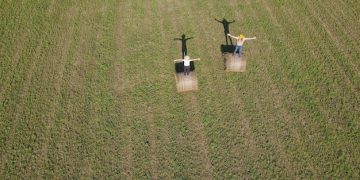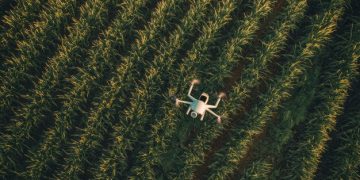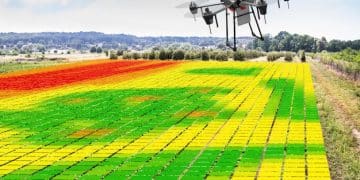Drone Crop Monitoring: Early Stress Detection for Better Yields
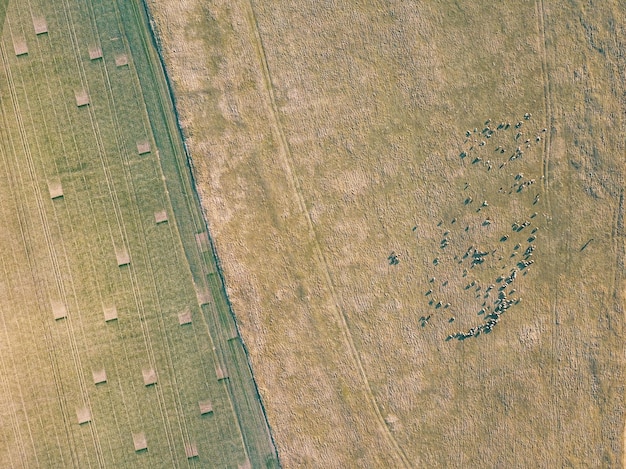
Drone-based crop monitoring revolutionizes agriculture by enabling farmers to identify and address plant stress up to three weeks earlier than traditional methods, using aerial imagery and data analytics for timely interventions and optimized crop health.
Drone-based crop monitoring: identify and address plant stress 3 weeks earlier than traditional methods is transforming agricultural practices by offering unprecedented insights into crop health. This technology allows for timely intervention, optimizing resource allocation and improving overall yields. Let’s explore how drones are revolutionizing crop management.
How Drone Technology Revolutionizes Crop Monitoring
Traditional crop monitoring methods often involve manual scouting, which is time-consuming and limited in scope. Drone technology offers a more efficient and comprehensive solution. By capturing high-resolution imagery, drones provide a bird’s-eye view of entire fields, enabling farmers to identify issues that might otherwise go unnoticed.
Enhanced Data Collection
Drones equipped with various sensors, such as multispectral and thermal cameras, can collect detailed data on plant health. This data includes information on chlorophyll levels, plant density, and temperature, which are crucial indicators of stress.
Real-Time Insights
Unlike traditional methods that may take days or weeks to yield results, drone-based monitoring provides real-time insights. This allows farmers to make timely decisions and implement targeted interventions, minimizing the impact of stress on crop yields.
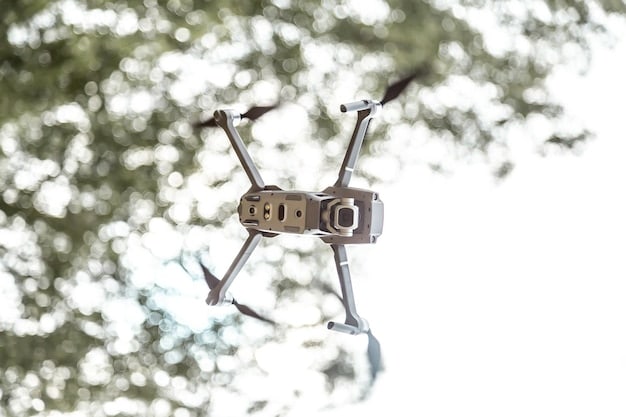
- Early detection of plant stress: Identify issues weeks before visible symptoms appear.
- Precise data collection: Gather detailed information on plant health using advanced sensors.
- Optimized resource management: Target interventions to specific areas, reducing waste.
- Improved yield potential: Enhance overall crop health and maximize productivity.
By leveraging drone technology, farmers can transform their approach to crop management. The ability to detect and address plant stress early leads to more efficient resource allocation, reduced costs, and ultimately, higher yields.
Identifying Plant Stress with Drone Imagery
One of the primary advantages of drone-based crop monitoring: identify and address plant stress 3 weeks earlier than traditional methods is the ability to identify plant stress early. Traditional visual inspections can often miss subtle signs of distress, leading to delayed interventions. Drones, on the other hand, can detect these early indicators through advanced imaging techniques.
Multispectral Imaging
Multispectral cameras capture images in multiple bands of the electromagnetic spectrum, including visible and near-infrared light. This allows for the creation of vegetation indices, such as the Normalized Difference Vegetation Index (NDVI), which indicates plant health and vigor.
Thermal Imaging
Thermal cameras measure the temperature of plants, providing insights into water stress and disease. Stressed plants often exhibit higher temperatures due to reduced transpiration, making thermal imaging a valuable tool for early detection.
Drones provide farmers the advantage of spotting problems like diseases, pest infestations, or nutrient deficiencies long before they could be observed by the human eye. This early detection allows for the implementation of timely and targeted measures.
Consider a scenario where a fungal infection is developing in a section of the field. A drone equipped with a multispectral camera can capture images that reveal subtle changes in the plant’s spectral signature, indicating the presence of the disease. The farmer can then apply fungicides to the affected area.
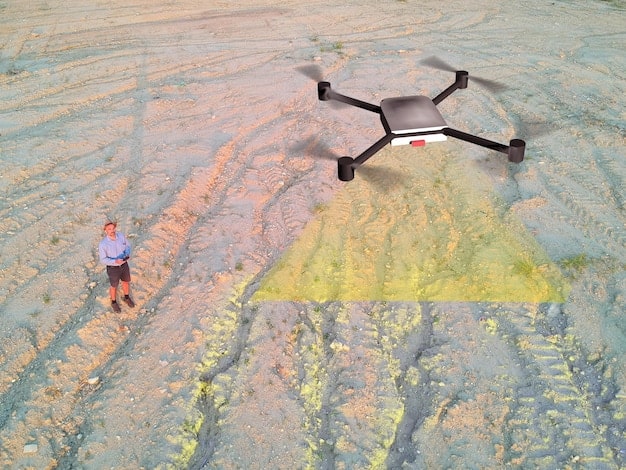
The Financial Benefits of Early Stress Detection
Early stress detection not only improves crop health but also offers significant financial benefits. By addressing issues promptly, farmers can minimize yield losses, reduce input costs, and optimize resource allocation, ultimately leading to higher profitability.
Reduced Input Costs
When stress is detected early, farmers can apply targeted treatments, such as fertilizers or pesticides, only to the affected areas. This reduces the overall consumption of these inputs, leading to cost savings and minimizing environmental impact.
Optimized Resource Allocation
Drones enable farmers to make data-driven decisions about irrigation, fertilization, and pest control. By understanding the specific needs of different areas within a field, resources can be allocated more efficiently, maximizing their impact and minimizing waste.
Increased Yields
By addressing plant stress early, farmers can prevent significant yield losses. Even a small increase in yield can translate to substantial financial gains, especially for large-scale operations.
For instance, consider a farmer managing a hundred-acre cornfield. Traditional methods might result in an average yield of 180 bushels per acre. By implementing drone-based crop monitoring and addressing stress early, the farmer could potentially increase the yield to 200 bushels per acre.
This increase of 20 bushels per acre adds up to an additional 2,000 bushels for the entire field. Assuming a market price of $4 per bushel, the farmer would generate an extra $8,000 in revenue.
Implementing Drone-Based Crop Monitoring
Implementing drone-based crop monitoring: identify and address plant stress 3 weeks earlier than traditional methods involves several key steps. From selecting the right drone and sensors to analyzing the data and integrating it into existing farm management practices, each step is crucial for success.
Selecting the Right Drone and Sensors
The first step is to choose a drone that is suitable for agricultural applications. Factors to consider include flight time, payload capacity, and ease of use. Additionally, selecting the appropriate sensors, such as multispectral or thermal cameras, is essential for capturing the necessary data.
Data Acquisition and Processing
Once the drone is equipped with the right sensors, the next step is to acquire data by flying over the fields. The captured imagery is then processed using specialized software to create orthomosaic maps and vegetation indices. This data is used to identify areas of plant stress and assess overall crop health.
Integration with Farm Management Systems
The final step is to integrate the data into existing farm management systems. This allows farmers to visualize the data, analyze trends, and make informed decisions about irrigation, fertilization, and pest control.
- Develop a clear monitoring plan: Define the objectives and scope of the monitoring program.
- Train personnel: Ensure that operators are properly trained in drone operation and data analysis.
- Follow best practices: Adhere to industry standards for data collection and processing.
- Regularly evaluate the program: Assess the effectiveness of the monitoring program and make adjustments as needed.
Case Studies: Success Stories in Drone-Based Crop Monitoring
To illustrate the effectiveness of drone-based crop monitoring: identify and address plant stress 3 weeks earlier than traditional methods, let’s examine a few case studies. These examples demonstrate how farmers have successfully implemented drone technology to improve crop health and increase yields.
Case Study 1: Precision Irrigation in Iowa
A corn farmer in Iowa implemented drone-based crop monitoring to optimize irrigation practices. By using thermal imaging to identify areas of water stress, the farmer was able to apply targeted irrigation, reducing water consumption and increasing yields by 15%.
Case Study 2: Early Disease Detection in California
A vineyard owner in California used drone-based multispectral imaging to detect early signs of disease. By identifying infected plants before symptoms became visible, the owner was able to apply targeted treatments and prevent the spread of the disease.
Case Study 3: Nutrient Management in Florida
A citrus grower in Florida used drone-based monitoring to assess nutrient levels in their orange trees. By analyzing vegetation indices, the grower was able to identify areas of nutrient deficiency and apply targeted fertilization, improving fruit quality and increasing yields by 10%.
In each of these cases, drone technology enabled farmers to make more informed decisions, leading to improved crop health, reduced costs, and increased profitability.
The Future of Drone Technology in Agriculture
The future of drone technology in agriculture is promising, with ongoing advancements in sensors, data analytics, and artificial intelligence. These innovations will further enhance the capabilities of drones, making them an even more valuable tool for crop monitoring and management.
Advancements in Sensor Technology
New sensors are being developed that can capture even more detailed data on plant health, including information on nutrient levels, disease presence, and pest infestations. These sensors will provide farmers with a more comprehensive understanding of their crops, allowing for even more precise interventions.
Integration with AI and Machine Learning
Artificial intelligence and machine learning algorithms are being integrated into drone-based monitoring systems to automate data analysis and provide real-time recommendations. These algorithms can identify patterns and trends in the data that would be difficult for humans to detect, enabling faster and more effective decision-making.
Autonomous Drones
Autonomous drones are being developed that can fly over fields, collect data, and return to base without human intervention. These drones will further streamline the monitoring process, reducing labor costs and improving efficiency.
As drone technology continues to evolve, it will play an increasingly important role in agriculture. By embracing these innovations, farmers can improve their crop management practices, reduce their environmental impact, and increase their profitability.
| Key Point | Brief Description |
|---|---|
| 🚀 Early Detection | Identifies plant stress weeks before traditional methods. |
| 📊 Data-Driven Decisions | Enables precise resource allocation based on plant needs. |
| 💰 Cost Reduction | Minimizes input waste and maximizes yield potential. |
| 🌽 Improved Yields | Enhances overall crop health and maximizes productivity. |
Frequently Asked Questions
▼
Drones can detect plant stress up to three weeks earlier than traditional methods, allowing for timely interventions and preventing significant yield losses. This early detection can be crucial for maintaining crop health.
▼
Drones use various sensors, including multispectral and thermal cameras. Multispectral cameras capture images across different light spectrums to assess plant health, while thermal cameras measure plant temperature.
▼
By pinpointing specific areas affected by stress, farmers can apply targeted treatments, such as fertilizers or pesticides, only where needed, thus minimizing the overall consumption of these inputs and reducing costs.
▼
Yes, drone data can be integrated into existing farm management systems, allowing farmers to visualize data, analyze trends, and make informed decisions on irrigation, fertilization, and pest control, all in one place.
▼
AI and machine learning algorithms automate data analysis and provide real-time recommendations. These algorithms identify patterns in data, enabling faster and more effective decision-making, ultimately improving crop health.
Conclusion
Drone-based crop monitoring: identify and address plant stress 3 weeks earlier than traditional methods offers a transformative approach to agriculture, empowering farmers with timely insights and precise interventions. By embracing this technology, the sector can optimize resource allocation, reduce costs, minimize environmental impact, and ultimately, achieve higher yields.


